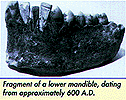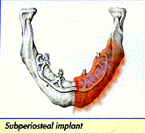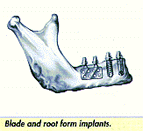HISTORY OF DENTAL IMPLANTS Overview of Tooth Replacement Therapy
Man has been searching for ways to replace missing teeth for thousands of years.  Ancient Egyptians used tooth-shaped shells and ivory to replace teeth. The Etruscans, living in what is now modern Italy, replaced missing teeth with artificial teeth carved from the bones of oxen. Further evidence of tooth replacement was found in 1931 while Dr. and Mrs. Wilson Popenoe, an archeological team, were excavating in Honduras.A mandible of Mayan origin was discovered that had tooth-shaped pieces of shells placed in the sockets of three missing lower incisor teeth.
Ancient Egyptians used tooth-shaped shells and ivory to replace teeth. The Etruscans, living in what is now modern Italy, replaced missing teeth with artificial teeth carved from the bones of oxen. Further evidence of tooth replacement was found in 1931 while Dr. and Mrs. Wilson Popenoe, an archeological team, were excavating in Honduras.A mandible of Mayan origin was discovered that had tooth-shaped pieces of shells placed in the sockets of three missing lower incisor teeth.
Modern implant dentistry began in the early 19th century. Much experimentation was being done about what material would work best as the replacement tooth. Attempts were first made at implanting natural teeth from another person’s mouth, but these implants suffered many infections and were rejected by the host. Implants made of gold, porcelain, silver and even lead were being tried, with only a fair measure of success and little or no predictability.
Early pioneers in this field include Dr. A.E. Strock, who, in 1931 suggested using Vitallium r, a metal alloy, for dental implants. In 1947, Manlio Formiggini of Italy developed an implant made of tantalum. At the same time, Raphael Chercheve was using implants made of a chrome-cobalt alloy. By 1964, commercially pure titanium was accepted as the material of choice for dental implants, and since this time, almost all dental implants are made of titanium. The body does not recognize titanium as a foreign material, resulting in less host rejection of the implant. Other areas of medicine recognize this fact and use titanium for other implants, such as joint replacements and heart valves.
Experimentation with implant designs, not just those that were shaped like the tooth root, was also being done. In 1941, Dr. Gustav Dahl of Sweden provided a retentive mechanism for jaws that were completely edentulous. This was the introduction of the subperiosteal implant. Dr. Leonard Linkow of New York introduced the blade form implant in 1967. These blades came in a variety of sizes and forms and were the most widely used type of implant until the 1980s.
 In the 1950s, a startling discovery was made which had great implications for Tooth Replacement Therapy. During an experiment involving the study of blood circulation in animals, Dr. Per-Ingvar Branemark discovered that the hollow titanium rod used in the study was not retrievable when the experiment was complete. Further studies showed that the animals’ bone had directly attached to the titanium surface. This phenomenon was called osseointegration, defined by the American Academy of Implant Dentistry as “the firm, direct and lasting biological attachment of a metallic implant to vital bone with no intervening connective tissue.” This firm anchor is what makes dental implants a wonderful option for replacing teeth.
In the 1950s, a startling discovery was made which had great implications for Tooth Replacement Therapy. During an experiment involving the study of blood circulation in animals, Dr. Per-Ingvar Branemark discovered that the hollow titanium rod used in the study was not retrievable when the experiment was complete. Further studies showed that the animals’ bone had directly attached to the titanium surface. This phenomenon was called osseointegration, defined by the American Academy of Implant Dentistry as “the firm, direct and lasting biological attachment of a metallic implant to vital bone with no intervening connective tissue.” This firm anchor is what makes dental implants a wonderful option for replacing teeth.
Whether implants are here to stay is no longer a question, but research into perfecting materials, procedures, and training will continue in this exciting field of dentistry.
Note: This information was taken from the article written by Dr. ME Ring. Ring ME: A Thousand Years of Dental Implants: A Definitive History, Parts 1 and 2. From The Compendium off Continuing Education in Dentistry, 16(10): 1060-1070, 16(11):1132-1142, 1995.
Implant Types
Dental implants come in a variety of shapes, sizes, and coatings. The two most popular coatings used are hydroxylapatite (HA) and titanium plasma sprayed (TPS). The concept of the coating is to provide a greater surface area for bone formation onto the implant and to expedite osseointegration.
There are two categories of implant designs:
- Subperiosteal
- Endosteal
Subperiosteal Implants
 A subperiosteal implant is placed onto the bone rather than into the bone, similar to a saddle. This type of implant is used most often to cover a large surface area, such as a completely edentulous mandible where there has been a severe amount of bone resorption and not enough bone to support endosteal implants. Although most of the implant structure is under the gum tissue, posts or bars remain exposed above the gums. The superstructure (denture or partial) attaches to these posts.
A subperiosteal implant is placed onto the bone rather than into the bone, similar to a saddle. This type of implant is used most often to cover a large surface area, such as a completely edentulous mandible where there has been a severe amount of bone resorption and not enough bone to support endosteal implants. Although most of the implant structure is under the gum tissue, posts or bars remain exposed above the gums. The superstructure (denture or partial) attaches to these posts.
Endosteal Implants
Endosteal implants are placed directly into the jawbone. The bone area must be sufficient to support the implants in height, width, and length. Endosteal implants can be either blade or root form. The type of endosteal implant selected is based on the amount of bone, the quality of bone, and the patient’s expectations of how the final restoration will look, feel and function.
Blade Form:
- The shape is wide and flat and comes in various heights and lengths.
- Popular for narrow bone that has sufficient height.
- May replace one or several teeth.

Root Form:
- Mimics the basic shape of the natural root.
- Available in a variety of lengths, widths and designs, Including cylinders (also referred to as “press-fit”), and screws (also referred to as “threaded”), or a combination of the two.
- May be used in any area of the mouth.
- May replace one or more teeth.
The dental implant supports an attachment/post called an abutment. A crown, bridge, or denture attaches to the abutment.
No single design is considered best for restoring all conditions. Each design type is useful in Tooth Replacement Therapy.